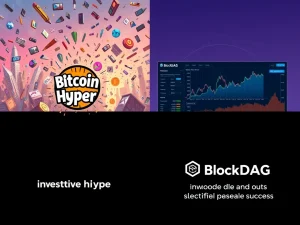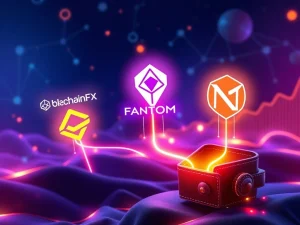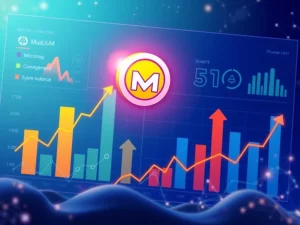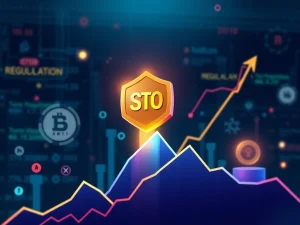BlockDAG Surges: Unprecedented 2660% Presale Gains Outpace Cardano Amid Developer Boom

In the ever-evolving world of cryptocurrency, projects constantly vie for attention, market share, and, crucially, real-world utility. While many follow traditional paths, some emerge with strategies that challenge the status quo, rapidly gaining momentum. One such contender, BlockDAG, is making significant waves, demonstrating a pragmatic and speed-focused approach that is yielding remarkable results. With an unprecedented 2660% return for early investors during its presale and a burgeoning ecosystem fueled by over 4,500 active developers, BlockDAG is not just growing; it’s actively outpacing established players like Cardano in key metrics, redefining what’s possible in blockchain innovation.
Cardano’s Vision: The Academic Approach to Blockchain
For years, Cardano has stood as a beacon of academic rigor in the blockchain space. Founded by Ethereum co-founder Charles Hoskinson, Cardano embarked on a mission to build a highly secure, scalable, and sustainable blockchain platform through a research-driven development model. Its foundational Ouroboros Proof-of-Stake protocol is celebrated for its energy efficiency and robust decentralized consensus mechanism. Cardano’s commitment to formal verification and peer-reviewed research has cultivated a reputation for reliability and long-term vision.
However, this meticulous approach has also presented challenges, particularly concerning developer accessibility and adoption:
- Haskell and Plutus: Cardano’s choice of Haskell for its smart contract language (Plutus) is lauded for its security and mathematical precision. Yet, it’s a niche language, less familiar to the vast majority of developers accustomed to more common programming languages like Solidity (Ethereum) or JavaScript. This steep learning curve can deter new developers, slowing down ecosystem growth.
- Slow Adoption: Despite its technical prowess, Cardano’s dApp ecosystem, by 2024, remained in relatively early testing phases. While projects like Djed (stablecoin) and SundaeSwap (DEX) have achieved functionality, their real-world usage and widespread adoption have been limited compared to their technical capabilities. The emphasis on theoretical soundness over rapid deployment has, at times, hindered its ability to capture immediate market opportunities.
- Complex Development Environment: The rigorous development cycle, while ensuring robustness, often means longer development times for new features and applications. This can translate into a slower time-to-market for innovative dApps, making it harder to compete with platforms that prioritize agility.
While Cardano maintains a strong market position and a dedicated community, its growth trajectory has been tempered by these factors, leading some to question its ability to adapt quickly to the fast-paced demands of the evolving crypto landscape. The focus keyword Cardano here highlights its unique, albeit challenging, strategic direction.
BlockDAG’s Ascent: A Pragmatic Powerhouse
In stark contrast to Cardano’s academic rigor, BlockDAG has embraced a pragmatic, speed-focused strategy that prioritizes accessibility, scalability, and rapid deployment. Built on a Directed Acyclic Graph (DAG) architecture, BlockDAG fundamentally redefines how transactions are processed on a blockchain. Unlike traditional linear blockchains, a DAG allows for parallel transaction processing, offering significant scalability advantages and near-instantaneous confirmations. This architectural choice is central to its ability to handle high transaction volumes efficiently, addressing one of the most pressing challenges in the blockchain space.
BlockDAG’s appeal extends beyond its underlying technology:
- Ethereum Compatibility: A critical differentiator for BlockDAG is its seamless compatibility with Ethereum-based tools. This means developers familiar with Ethereum’s robust ecosystem (Solidity, MetaMask, Truffle, etc.) can easily transition to BlockDAG without a steep learning curve. This significantly lowers entry barriers, attracting a broader pool of talent.
- Low-Code Smart Contract Builder: Further enhancing developer accessibility, BlockDAG offers a low-code smart contract builder. This innovative tool empowers teams, even those with limited blockchain development expertise, to deploy decentralized applications rapidly. This ‘plug-and-play’ approach accelerates innovation and reduces development cycles from months to weeks.
- Vibrant Testnet Activity: The real-world impact of BlockDAG’s strategy is evident in its burgeoning testnet activity. Over 4,500 builders are already contributing to more than 300 projects, spanning diverse sectors such as payments, artificial intelligence (AI), and decentralized finance (DeFi). Many of these projects are in active testing, demonstrating tangible progress and a vibrant, engaged community.
This momentum is not just theoretical; it’s backed by significant financial success, particularly in its ongoing presale. The platform’s ability to attract a large and active developer base, combined with its technical agility, positions BlockDAG as a formidable contender in the race for widespread blockchain adoption.
Unpacking the Presale Phenomenon: Why BlockDAG’s Gains Are Turning Heads
The financial success of BlockDAG‘s presale is nothing short of phenomenal, serving as a powerful indicator of market confidence and investor enthusiasm. The project has successfully raised an astounding $351 million, with 24.3 billion BDAG coins sold across various batches. This impressive fundraising validates BlockDAG’s value proposition and its potential for significant returns.
For early contributors, the returns have been particularly rewarding. Since the initial batch, investors have seen an incredible 2,660% return on their investment. This level of growth in a relatively short period is rare in the crypto market and speaks volumes about the project’s perceived future value. The current projection of a 3,025% return if the coin launches at $0.05 further underscores its appeal and the high expectations surrounding its mainnet launch.
Let’s break down the key figures:
| Metric | Value |
|---|---|
| Total Presale Raised | $351 Million |
| BDAG Coins Sold | 24.3 Billion |
| Return for Early Contributors | 2,660% |
| Projected Return at $0.05 Launch | 3,025% |
| Current Batch Price (example) | $0.0095 (assuming a later batch) |
| Initial Batch Price (example) | $0.001 (approx.) |
These robust presale gains are not merely numbers; they represent tangible progress and a strong belief from the community in BlockDAG’s vision and execution. Such figures often attract further investment and attention, creating a virtuous cycle of growth and adoption. The success of the presale is a testament to BlockDAG’s effective market strategy and its ability to resonate with both developers and investors looking for high-growth potential in the blockchain space.
Fueling the Future: BlockDAG’s Unrivaled Developer Engagement
The true strength of any blockchain ecosystem lies in its community of builders, and here, BlockDAG truly shines. The platform has fostered an environment that has attracted over 4,500 active developers, a figure that significantly surpasses the engagement seen on many other nascent, and even some established, platforms. This massive influx of talent is directly contributing to more than 300 projects currently in various stages of development and testing on BlockDAG’s testnet.
What drives this remarkable developer engagement?
- Ease of Use: As previously mentioned, BlockDAG’s compatibility with Ethereum-based tools and its low-code smart contract builder dramatically reduce the learning curve. Developers can leverage their existing skill sets, enabling them to start building almost immediately rather than spending weeks or months mastering new languages or frameworks.
- Scalability and Speed: The underlying DAG architecture offers inherent advantages in terms of transaction speed and scalability. Developers are drawn to platforms where their applications can perform efficiently without being bottlenecked by network congestion or high fees. BlockDAG’s ability to process transactions in parallel makes it an attractive environment for resource-intensive dApps.
- Active Community Support: A thriving developer community often creates a self-reinforcing cycle of support, knowledge sharing, and collaboration. BlockDAG’s emphasis on fostering this community, through forums, documentation, and perhaps even hackathons (implied by the number of projects), encourages more builders to join and contribute.
- Real-World Application Focus: The diversity of projects on the testnet—spanning payments, AI, and finance—indicates that developers are building solutions for tangible, real-world problems. This focus on utility, rather than just theoretical concepts, makes the platform more appealing to practical-minded developers.
This high level of developer activity is a crucial metric for assessing the long-term viability and potential for innovation within a blockchain ecosystem. It signifies a robust and growing network effect, where more developers lead to more dApps, which in turn attracts more users, creating a powerful growth engine. BlockDAG’s success in cultivating such a vibrant developer community is a strong testament to its strategic approach and its potential to become a leading platform for decentralized application development.
The Crossroads of Blockchain Innovation: Cardano vs. BlockDAG
The contrasting strategies of Cardano and BlockDAG offer a compelling case study in the divergent paths of blockchain innovation. While both aim to build robust decentralized systems, their methods and immediate outcomes vary significantly.
Let’s compare their approaches:
| Feature | Cardano’s Approach | BlockDAG’s Approach |
|---|---|---|
| Development Model | Research-driven, academic rigor, formal verification. | Pragmatic, speed-focused, accessibility-first. |
| Core Architecture | Ouroboros PoS, traditional linear blockchain. | Directed Acyclic Graph (DAG), parallel processing. |
| Smart Contract Language | Haskell/Plutus (high precision, niche). | Ethereum-compatible tools, low-code builder (broad accessibility). |
| Developer Barrier | High (steep learning curve for Haskell). | Low (familiar tools, low-code options). |
| Scalability Approach | Layer-2 solutions (Hydra), long-term roadmap. | Inherent DAG architecture for parallel processing. |
| Community Engagement | Strong, but development-focused community. | Rapidly growing, highly active developer base (4500+). |
| Market Focus | Long-term infrastructure, secure foundations. | Immediate usability, rapid dApp deployment, market responsiveness. |
| Current Momentum (2024) | Steady, but slower dApp adoption. | Explosive presale, significant testnet activity. |
Cardano’s commitment to academic rigor ensures a robust and theoretically sound infrastructure. However, this often translates into slower practical implementation, limiting its short-term utility and adoption compared to more agile platforms. BlockDAG, on the other hand, prioritizes accessibility and speed, fostering rapid community participation and tangible progress, as evidenced by its testnet activity and impressive presale figures.
While critics might argue that BlockDAG’s fast-paced approach could potentially sacrifice security for speed, its emphasis on Ethereum compatibility and rigorous testing phases suggests a careful balance between innovation and stability. The platform leverages established and audited Ethereum standards where possible, mitigating some of the inherent risks of rapid development.
Ultimately, the divergence in their strategies is shaping their respective trajectories. Cardano remains a secure, long-term option for those prioritizing foundational integrity. BlockDAG’s focus on immediate usability, scalability, and developer-friendliness aligns more closely with current market demands for practical, high-performance blockchain solutions. Its ability to attract a vast number of builders with minimal technical barriers positions it as a compelling case study in the evolving landscape of blockchain innovation, demonstrating that pragmatic agility can lead to rapid ecosystem growth and significant market impact.
Investment Insights: Navigating the Landscape
For investors, the choice between projects like Cardano and BlockDAG hinges significantly on their priorities and risk appetite. Both offer unique value propositions, but their current stages and strategic orientations suggest different investment profiles.
-
Cardano: The Long-Term Bet
Investing in Cardano is often viewed as a long-term play on fundamental technical soundness and a meticulously planned roadmap. Its established market presence, robust research, and commitment to decentralization offer a degree of stability. Investors who prioritize security, sustainability, and a gradual, well-audited development cycle might find Cardano more appealing. However, they should be prepared for potentially slower growth compared to more agile newcomers, as its methodical pace can delay the realization of its full potential in terms of widespread dApp adoption.
-
BlockDAG: The Momentum Play
BlockDAG, with its explosive presale gains and rapid developer engagement, represents a short-to-medium-term momentum play. Its focus on immediate usability, scalability, and developer-friendliness positions it for rapid ecosystem growth. Investors seeking higher potential returns in a shorter timeframe, and who are comfortable with the inherent volatility of newer, high-growth projects, might find BlockDAG a more compelling option. The significant presale success and active testnet signal strong community backing and tangible progress, which can translate into continued upward price movement post-launch.
It’s crucial for investors to conduct thorough due diligence, understanding the underlying technology, team, roadmap, and market sentiment for both projects. Diversification remains a wise strategy, allowing investors to capitalize on different types of growth opportunities within the dynamic crypto market. BlockDAG’s real-world engagement, as evidenced by its substantial developer base and community-driven presale, clearly signals its potential to be a dominant force, making it a project worth close observation for those tracking the next wave of blockchain success stories.
Conclusion: BlockDAG’s Ascendancy in a Dynamic Market
The cryptocurrency landscape is a battleground of ideas, technologies, and strategies. While Cardano has meticulously built a foundation of academic rigor and security, its methodical pace has presented challenges in achieving rapid widespread adoption. In this dynamic environment, BlockDAG has emerged as a formidable force, demonstrating that a pragmatic, speed-focused approach, coupled with exceptional developer accessibility and robust scalability, can lead to unprecedented growth. Its astounding 2660% presale gains and the vibrant activity of over 4,500 active developers are not just impressive statistics; they are clear indicators of tangible progress and a rapidly expanding ecosystem. BlockDAG’s commitment to lowering entry barriers for builders and its inherent scalability via DAG architecture positions it as a leader in the next phase of blockchain innovation. As the market continues to prioritize real-world utility and rapid deployment, BlockDAG’s strategic choices appear to be aligning perfectly with the demands of a fast-evolving decentralized future, making it a compelling case study of success in an intensely competitive arena.
Frequently Asked Questions (FAQs)
Q1: What is the main difference between BlockDAG and Cardano’s approach to blockchain?
Cardano adopts a research-driven, academic approach, emphasizing formal verification and slow, meticulous development using Haskell/Plutus. BlockDAG, in contrast, uses a pragmatic, speed-focused strategy with a Directed Acyclic Graph (DAG) architecture for parallel processing, prioritizing developer accessibility through Ethereum compatibility and low-code tools for rapid dApp deployment.
Q2: How significant are BlockDAG’s presale gains?
BlockDAG’s presale has been exceptionally successful, raising $351 million and selling 24.3 billion BDAG coins. Early contributors have seen an incredible 2,660% return on their investment, with projections for even higher returns if the coin launches at $0.05. This demonstrates strong market confidence and high growth potential.
Q3: Why is developer engagement important, and how does BlockDAG compare?
Developer engagement is crucial as it indicates the health and future growth potential of a blockchain ecosystem. More developers mean more dApps, which attracts more users. BlockDAG has attracted over 4,500 active developers working on 300+ projects on its testnet, significantly outpacing many competitors, including Cardano, in terms of active builder participation due to its accessible development environment.
Q4: What are the benefits of BlockDAG’s DAG architecture?
BlockDAG’s Directed Acyclic Graph (DAG) architecture enables parallel transaction processing, which offers significant advantages in scalability and transaction speed compared to traditional linear blockchains. This allows BlockDAG to handle a much higher volume of transactions efficiently, leading to faster confirmations and lower fees, making it ideal for high-throughput applications.
Q5: Is BlockDAG a secure platform given its fast-paced development?
While BlockDAG’s fast-paced approach might raise questions about security, the platform mitigates these concerns through its compatibility with established Ethereum-based tools and rigorous testing phases. By leveraging battle-tested Ethereum standards and focusing on thorough testing, BlockDAG aims to balance innovation and stability, ensuring a robust and secure environment for dApps.
Q6: How should investors choose between Cardano and BlockDAG?
The choice depends on investment priorities. Cardano is often considered a long-term investment for those seeking foundational technical soundness and gradual, secure development. BlockDAG, with its explosive growth and focus on immediate utility and developer adoption, is more suited for investors looking for short-to-medium-term momentum and higher potential returns, albeit with the inherent volatility of newer projects. Diversification and thorough research are always recommended.










